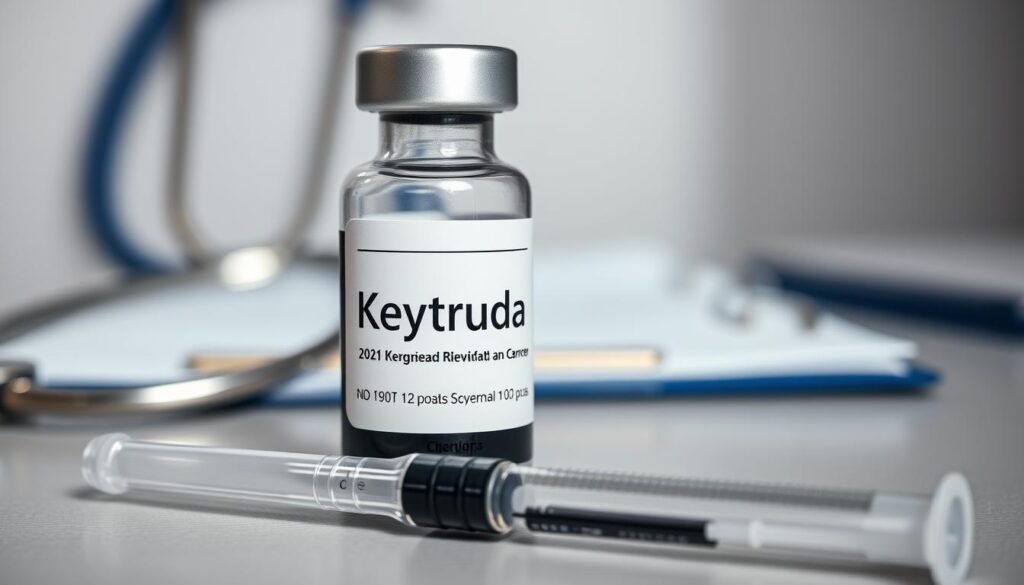Lung cancer is the top cause of cancer-related deaths worldwide. Every year, it’s linked to about 1.8 million deaths. Keytruda (pembrolizumab), an immunotherapy, is changing how lung cancer is treated. It boosts the immune system to identify and destroy tumor cells. This is crucial for treating non-small cell lung cancer, the most common type.
Keytruda clinical trials for lung cancer are crucial. They find the best ways to improve patient outcomes. Pembrolizumab’s role in changing lung cancer care is huge. It offers hope for better survival rates. And it can improve the quality of life for patients facing this tough disease.
Key Takeaways
- Lung cancer is the leading cause of cancer-related deaths, with approximately 1.8 million deaths annually.
- Keytruda is a pioneering immunotherapy that enhances the immune system’s ability to combat tumor cells.
- Numerous clinical trials are crucial for identifying effective lung cancer treatment strategies.
- Pembrolizumab plays a significant role in non-small cell lung cancer treatment.
- Research continues to improve patient outcomes and survival rates in lung cancer populations.
- Keytruda’s advancements signal a critical evolution in lung cancer treatment options.
Introduction to Keytruda and Lung Cancer Treatment
Lung cancer is a top cause of cancer deaths worldwide. Effective treatments are essential. Keytruda (pembrolizumab) is key, especially for non-small cell lung cancer (NSCLC) with PD-L1. Clinical studies back its growing role in fighting this disease.
Keytruda boosts the body’s defense against cancer cells. It targets the PD-1 receptor used by cancer to hide from the immune system. If a patient has high PD-L1, Keytruda could be their best option. Studies show it may work better than older treatments.
Many studies focus on how well and safely Keytruda works for lung cancer. Trials like KEYNOTE-024 and KEYNOTE-010 show it improves survival. This makes Keytruda a crucial part of lung cancer care today.
Understanding Pembrolizumab Immunotherapy
Pembrolizumab immunotherapy is a big step forward in treating cancer, especially lung cancer. It acts as an anti-PD-1 agent. It stops PD-1 receptors on T-cells from connecting with PD-L1 and PD-L2. This keeps T-cells active, letting them attack tumor cells better. In keytruda clinical trials for lung cancer, it has shown good results in enhancing immune responses against cancer.
This therapy works differently for various people. Those with a lot of mutations in their tumors seem to benefit more. They show better survival rates in clinical studies. However, there are side effects. These include feeling tired, skin rashes, diarrhea, and muscle aches. Kids may experience fever and vomiting more often than adults do.
In clinical settings, pembrolizumab is sometimes used with other treatments. If used with chemotherapy, patients might lose hair, get infections easier, and have joint pain. There’s a risk of severe immune-related side effects. These can be life-threatening if not managed well. It’s important for patients and doctors to talk and manage these risks.
Keytruda Clinical Trials Lung Cancer
The fight against lung cancer has changed a lot because of keytruda clinical trials. Merck has played a big role in this research. It has led to Keytruda, also called Pembrolizumab, being tested in different ways. Trials like KEYNOTE-189 and KEYNOTE-042 have shown us how effective and safe it is for patients.
KEYNOTE-189 was about helping patients with advanced non-small cell lung cancer who hadn’t received treatment before. They got Keytruda along with chemotherapy. This mix helped patients live longer compared to just chemotherapy. KEYNOTE-042 looked at using Keytruda alone in patients with the same kind of lung cancer, but without prior treatment. The trial highlighted how important it is to choose patients carefully, based on PD-L1 levels in their tumors. Different groups of patients responded differently.
Ongoing studies are always looking into how Keytruda can be used with new treatments. For instance, researchers are studying its use with a type of radiation therapy called stereotactic body radiotherapy. They’re trying to see if this can lead to better outcomes. They also want to find out which patients will benefit the most from this combination.
Overall, these trials are all about understanding Keytruda better. The goal is to learn how to use it more effectively. By doing so, doctors hope to improve how long patients with lung cancer can live.
| Trial Name | Focus | Findings |
|---|---|---|
| KEYNOTE-189 | Metastatic NSCLC with chemotherapy | Improved overall survival rates |
| KEYNOTE-042 | Untreated NSCLC monotherapy | Effectiveness based on PD-L1 expression levels |
| KEYNOTE-867 | Unresected stage I or II NSCLC plus SBRT | No improvement in EFS or OS |
| KEYNOTE-630 | High-risk locally advanced cSCC | No statistical significance in RFS |
Recent Advancements in Lung Cancer Treatment Options
Lung cancer is a major health issue with around 2.4 million new cases in 2022. Most cases are non-small cell lung cancer (NSCLC), making up 80% of diagnoses. The focus now is on new therapies that improve survival and life quality for patients.
Keytruda, or pembrolizumab, has changed the game for NSCLC treatment. It’s used with chemo for certain NSCLC patients. One major study, the INTerpath-009 Phase 3 trial, looks at Keytruda’s effect on NSCLC patients after surgery and therapy.
- Keytruda is used for resectable NSCLC treatment.
- It’s used alone after surgery and chemo for Stage IB, II, or IIIA NSCLC.
- Trials are ongoing to see how well it works long term.
Immune checkpoint inhibitors like Keytruda are showing great promise. They offer lasting effects and much better survival rates than old treatments. For example, some NSCLC patients on these therapies have seen five-year survival rates up to 32%.

New drug combinations are also being explored. These target genetic changes like BRAF and KRAS mutations. It’s a big step forward, offering hope to NSCLC patients, especially those with no known mutations.
The goal is to find treatments that are just right for each patient. Knowing how PD-L1 affects the disease helps doctors choose better treatments. This can make a huge difference for people fighting lung cancer.
The Role of Non-Small Cell Lung Cancer Trials
Non-small cell lung cancer (NSCLC) trials are key in making better treatments and improving lives. They tackle the unique problems of NSCLC, which is 85% of lung cancer cases. With 13% of all cancer diagnoses worldwide being lung cancer, the push for new treatments is crucial.
Keytruda clinical trials for lung cancer show promising outcomes, especially when used with chemotherapy. The Phase 3 KEYNOTE-189 trial showed a five-year survival rate of 19.4% for patients treated with Keytruda and chemo for metastatic nonsquamous NSCLC. The KEYNOTE-407 trial found a five-year survival rate of 18.4% for metastatic squamous NSCLC.
Using biomarker profiles to group patients is a big step forward in clinical trials. It helps find mutations like EGFR and ALK. This means doctors can pick more effective treatments, making a big difference in survival rates.
The studies showed that Keytruda with chemo cuts the risk of dying by 40% in KEYNOTE-189 and by 29% in KEYNOTE-407, compared to just chemo. This shows how crucial NSCLC trials are. They keep improving how we treat this cancer and prove how well immunotherapy works in saving lives.
| Trial Name | Treatment | Five-Year OS Rate | Median Overall Survival (months) | Risk Reduction of Death |
|---|---|---|---|---|
| KEYNOTE-189 | Keytruda + Chemotherapy | 19.4% | 22.0 | 40% |
| KEYNOTE-407 | Keytruda + Chemotherapy | 18.4% | 17.2 | 29% |
Ongoing NSCLC trials are crucial. They help us understand how treatments like Keytruda work over time. This is important in finding even better treatments for lung cancer patients.
Keytruda Dosage and Administration Guidelines
Knowing the keytruda dosage and how it’s given is key for cancer care. Keytruda comes as a shot of 100 mg/4 mL (25 mg/mL). The amount given depends on the cancer type and its stage.

For those with melanoma that can’t be removed or has spread, they get 200 mg through IV every three weeks. Or they can get 400 mg every six weeks. This goes on until the disease gets worse or the side effects are too much. The same amounts are used even after melanoma is surgically removed.
In treating non-small cell lung cancer (NSCLC), dosages stay the same as melanoma, according to keytruda clinical trials lung cancer. This is true for both early and late stages of NSCLC.
For urothelial carcinoma, 200 mg IV every three weeks or 400 mg every six weeks is standard. This continues until the cancer gets worse or up to 24 months. If Keytruda is given with enfortumab vedotin, Pembrolizumab must be given around 30 minutes after enfortumab.
In treating head and neck squamous cell carcinoma, the approach is similar. Doctors administer 200 mg IV every three weeks or 400 mg every six weeks. This continues until patients respond well to treatment. The same schedule is used for classical Hodgkin lymphoma. Adjustments are made based on individual patient needs.
Being up to date on the keytruda dosage helps adjust treatments, which can greatly affect outcomes during keytruda clinical trials lung cancer. Checking for immune reactions and monitoring liver enzymes are key for long-term care.
Combining Keytruda with Chemotherapy
Using keytruda with chemotherapy is now a leading method for lung cancer care. It shows promise, especially for metastatic lung cancer. Studies show this mix can improve results for patients. It gives new hope to those with tough cases of the sickness.
A study, known as the Phase 3 KEYNOTE-604 trial, showed progress. It noted better survival rates without disease worsening in some patients. Patients had extensive stage small cell lung cancer. Although not all results were statistically clear, this points to potential benefits.
Patients report several side effects from these treatments. The common ones are:
- Nausea
- Constipation
- Trouble breathing
Combining keytruda with specific drugs and radiation can lead to other side effects. These include:
- Hair loss
- Weight loss
- Inflammation of the nerves
Keytruda combined with other treatments can cause different side effects. For example, enfortumab vedotin use can change taste and cause hair loss. The side effects vary with each chemotherapy mix. This highlights the need to watch patients closely and adjust treatments as needed.
Keytruda’s role in treating lung cancer is growing. This growth is supported by a large research program. It includes over 10,000 patients in more than 1,000 studies. As studies continue, we will learn more about combining immunotherapy with chemotherapy. This knowledge will help improve lung cancer treatments in the future.
Latest Findings from Keytruda Clinical Trials
Recent keytruda clinical trials for lung cancer have revealed important insights. This new treatment, pembrolizumab, could greatly help patients. The phase III KEYNOTE-042 study showed it might be better than traditional chemotherapy.
Research shows high PD-L1 expression leads to better survival rates. Five-year survival rates were 21.9% for those with a high PD-L1 score, higher than others. This highlights the importance of PD-L1 in determining treatment for lung cancer.
Pembrolizumab’s safety profile is also comforting. Only 63.8% experienced side effects, much less than the 90.2% with chemotherapy. This makes pembrolizumab a more tolerable treatment option.
An 84.3% response rate was seen in patients who completed 35 cycles. This cements keytruda as a top choice for lung cancer therapy. It also showed better progression-free survival rates than traditional methods.

Keytruda clinical trials highlight the changing treatment landscape for lung cancer. These findings emphasize the effectiveness, safety, and tolerance of pembrolizumab. They mark a significant step forward in lung cancer research.
Keytruda Survival Rates in Lung Cancer Patients
Keytruda, also called pembrolizumab, is a big step forward in lung cancer care. It’s especially important for advanced non-small cell lung cancer (NSCLC) patients with high PD-L1. Recent results show Keytruda has almost doubled the five-year survival rate to 31.9%. This is in comparison to just 16.3% with standard chemotherapy for patients with a PD-L1 tumor score of 50% or higher.
Keytruda clinical trials indicate a 38% lower death risk than chemotherapy. The median survival time for Keytruda users is 26.3 months. For chemotherapy, it’s 13.4 months. This shows Keytruda’s potential to change patient outcomes dramatically.
Patients taking Keytruda also see long-lasting responses. The average response time is 29.1 months, much longer than chemotherapy’s 6.3 months. After two years of Keytruda treatment, 81.4% lived for five more years. Nearly half didn’t need more treatment.
Before 2014, the five-year survival rate for advanced NSCLC was only 5%. With Keytruda, the success rate jumps to 46.1%, beating chemotherapy’s 31.1%. Long-term safety analyses show only 15.4% had severe side effects after two years.
Summing up, Keytruda changes the game in lung cancer treatment. Through Keytruda clinical trials lung cancer, it brings hope and better life chances to many.
| Outcome | Keytruda | Chemotherapy |
|---|---|---|
| 5-Year Survival Rate | 31.9% | 16.3% |
| Median OS | 26.3 months | 13.4 months |
| Duration of Response | 29.1 months | 6.3 months |
| Alive After 5 Years (2 Years of Treatment) | 81.4% | N/A |
| Objective Response Rate | 46.1% | 31.1% |
Identifying Lung Cancer Biomarkers
Lung cancer is a major health issue in the U.S., leading to many new cases and deaths in 2015. It’s crucial we improve how we detect and treat it. Identifying lung cancer biomarkers is key to this effort. These biomarkers help predict how a patient might respond to treatments like Keytruda.
Biomarkers are vital for tailoring lung cancer treatment to each patient. About 10% of U.S. adenocarcinoma patients have the EGFR mutation. In East Asia, this percentage increases to 30-50%. The ALK gene rearrangement is found in 3.7% to 7% of non-small cell lung cancer cases. This underscores the need for thorough biomarker testing.
Researchers are finding many lung cancer biomarkers, such as:
- ALK
- BRAF
- EGFR
- HER2
- KRAS
- MET
- NTRK
- PD-L1
- PD1
- TMB
- RET
- ROS1
- STK11
Knowing about these biomarkers helps doctors create better treatment plans. For instance, patients with the EGFR mutations react well 55% to 78% of the time to certain drugs. Testing for biomarkers can review mutations, protein levels, and tumor DNA. This greatly affects how lung cancer is treated.
Staying informed about the latest research, especially keytruda clinical trials lung cancer, leads to better patient outcomes. Personalized medicine, through biomarker identification, improves treatment approaches and aids in clinical decisions.
| Biomarker | Mutation Frequency | Treatment Response |
|---|---|---|
| EGFR | 10% (30-50% in East Asia) | High response (55%-78% to TKIs) |
| ALK | 3.7% – 7% | Targeted therapies available |
| KRAS | 25% – 35% | New therapies in development |
| HER2 | 1.6% – 4% | Targeted treatment options |
In summary, finding biomarkers is crucial in improving lung cancer treatments. By focusing on these indicators, doctors can better help patients and influence how lung cancer is treated.
Keytruda Side Effects and Management Strategies
Keytruda is a well-known treatment for various cancers. During therapy, patients might face different side effects. It’s key to know these side effects to care for patients well.
Common keytruda side effects include:
- Nausea
- Skin changes
- Breathlessness
- Low thyroid hormone levels
- Loss of appetite
- Headaches
- Diarrhea or constipation
- Pain and fatigue
- Fluid retention
- High temperature
Occasional side effects are less common. Yet, they can occur:
- Drop in white blood cell and platelet count
- Allergic reactions
- Colitis
- Muscle inflammation
- High thyroid hormone levels
- Dizziness and sleep difficulties
- Changes in taste and dry eyes
- Hair loss and joint swelling
Some patients may experience rare, but serious, side effects:
- Severe skin reactions
- Inflammation in various organs
- Adrenal gland damage
- Type 1 diabetes
- Seizures
- Severe muscle weakness
- Meningitis and fluid collection around the heart
Handling keytruda side effects properly is crucial. This ensures patient safety and treatment continuation. Effective strategies cover:
- Regular checks on vital signs and lab tests.
- Treating symptoms like nausea, tiredness, and pain.
- Educating on spotting severe side effects early.
- Tailoring therapies to each patient.
- Offering support, like counseling or support groups.
With a focused plan to manage side effects, healthcare teams can guide patients better through treatment.
| Frequency | Side Effects |
|---|---|
| Common (> 10%) | Nausea, skin changes, breathlessness, low thyroid hormone levels, loss of appetite, headaches, diarrhea, fatigue, high temperature |
| Occasional (1-10%) | Drop in white blood cells, allergic reactions, colitis, muscle inflammation, sleep difficulties, dizziness, hair loss |
| Rare (< 1%) | Severe skin reactions, adrenal gland damage, type 1 diabetes, seizures, eye inflammation, meningitis |
Conclusion
Keytruda is now a key player in fighting non-small cell lung cancer. It gives patients hope with its new approach as an immune checkpoint inhibitor. Studies show that it helps improve survival rates for patients with certain lung cancers. It’s important to know about lung cancer treatments and how well they work.
The results from Keytruda’s clinical trials highlight the need for more research. As new treatments develop, it’s crucial to personalize treatment plans. Testing for specific biomarkers can help make treatments more effective, improving survival rates for lung cancer patients.
The introduction of Keytruda in lung cancer treatment is a significant advancement. Researchers and doctors continue to seek new treatment combinations. With ongoing research, prospects for lung cancer patients are getting brighter, leading to better health outcomes.